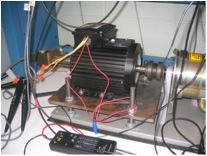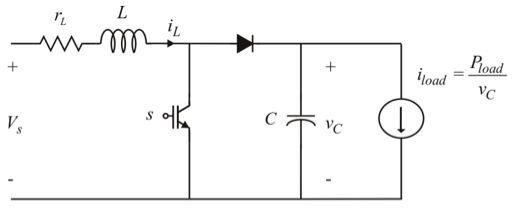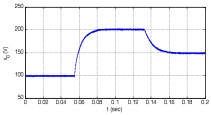Electric Drive and Power Converter Controls
Purdue has been highly active in the area of controls for electric machinery, electric drive systems, and power electronic converters, and even systems of power electronic converters. In the arena of induction motor drive controls, much of Purdue’s efforts have focused on Maximum Torque Per Amp controls which offer near optimal system efficiency – potentially much higher than that of either field-oriented control or voltz-per-hertz control depending upon operating point. The first contributions of this were set forth in [1-3] which offer a control based on the standard induction motor model. Later, improved versions of this strategy were set forth that address rotor resistance variation, magnetic saturation, and distributed circuit effects in the machine rotor [4-7].
Purdue researchers have also been highly involved in control development for permanent magnet synchronous machines. In [8], a feedback based approach to flux weakening is set forth which allows flux weakening to occur without knowledge of the machine model (flux-weakening is a technique used to increase the speed range). In [9] an approach is set forth to reduce sensor requirements, thereby reducing the cost of the drive system. In [10-13], the performance of permanent-magnet synchronous machines is set forth. Therein, the optimal current waveform in terms of loss and torque ripple is found, and a method to obtain this waveform is set forth. This control strategy addresses the problems of reducing loss and torque ripple (which causes acoustic noise). The control which obtains the desired waveform is generalized in [14]. This paper introduces the multiple reference frame synchronous estimator / regulator concept, a control which can exactly regulate a waveform with a prescribed harmonic content. This can be used to inject desired harmonic content (for example, to reduce cogging torque) or to make sure that irregularities in a machine (such as a slight imbalance) do not introduce objectionable harmonics. The application of these concepts to the switched reluctance machine is described in [15-16].

Permanent Magnet Synchronous Machine Drive
Although much of Purdue’s control efforts have been focused on electric machinery, there has been considerable work in the control of power electronic converters as well. For example, in [17] an inverter control strategy is set forth for 3-phase power regulation. The strategy is simple, effective, and offers essentially perfect bus voltage regulation. The control strategy for a power-electronics based distribution transformer is set forth in [18-19]. One common theme in power systems containing numerous power electronic converters is stability. Power electronic converters often appear as constant power loads to the system, and this class of load is destabilizing. A strategy to mitigate this effect is set forth in [20-21].
Purdue is also focused on high-power electronic converters which have attracted interest for High Voltage Direct Current (HVDC) converter stations and also Flexible AC transmission Systems (FACTS). Topics of research interests are on development of pulsewidth modulation techniques, modeling, and control of multi-level and multi-module converters [22]-[29].
Purdue has had considerable efforts in power electronics based Marine and Aerospace Power Systems, and this interest has included the controls. In [30], a systematic means of semiautomatically designing system controls is set forth. Purdue has also been interested in exotic power systems. The control design of a 400 Hz/20 kHz aerospace power system is indicative of these efforts and is described in [31].
Recently, Purdue has been able to implement real-time Model Predictive Control (MPC) of dc-dc converters. In MPC, control is determined at each sampling, through the solution of an optimal control problem. The optimal control formulation for switching systems is presented in [32]. In [33]-[36], the optimization is implemented within a Model Predictive Control framework for control of switching in a dc-dc boost converter. The primary focus of this research is on the real-time implementation of the control method, wherein the control problem is solved online in less than one switch period. A benefit of MPC control is that it achieves fast dynamic response over a wide range of operating points, even for systems with dynamic loads.


Model Predictive Control of the boost converter (left) results in fast dynamic response (ie. voltage tracking) over multiple operating points (right)
References
[1] O. Wasynczuk, S.D. Sudhoff, I.G. Hansen, L.M. Taylor, “A Maximum Torque per Ampere Control Strategy for Induction Motor Drives,” Proceedings of the 1997 Naval Symposium on Electric Machines, July 28-31, 1997, Newport, RI, pp.111-118.
[2] O. Wasynczuk, S.D. Sudhoff, K.A. Corzine, J.L. Tichenor, P.C. Krause, I.G. Hansen, and L.M Taylor, “A Maximum Torque Per Ampere Control Strategy for Induction Motor Drives,” IEEE Transactions on Energy Conversion, Vol. 13, No. 2, June 1998, pp. 163-169.
[3] O. Wasynczuk, S.D. Sudhoff, “Maximum Torque Per Ampere Induction Motor Drives – An Alternative to Field-Oriented Control,”. 1998 SAE Transactions, Journal of Aerospace, Section 1, pp. 85-93. Named Best Paper of the 1998 SAE Aerospace Power Systems Conference
[4] C. Kwon, S.D. Sudhoff, “An Improved Maximum Torque Per Amp Control for Induction Machine Drives,” APEC2005, March 2005, Austin, Texas, USA
[5] Chunki Kwon, Scott D. Sudhoff, “An On-line Rotor Resistance Estimator for Induction Machine Drives,” 2005 International Electric Machines and Drives Conference, San Antonio, Texas, May 15-18, 2005
[6] Chunki Kwon, Scott D. Sudhoff, “An Adaptive Maximum Torque Per Amp Strategy,” 2005 International Electric Machines and Drives Conference, San Antonio, Texas, May 15-18, 2005
[7] C. Kwon, S.D. Sudhoff, “A Genetic Algorithm Based Induction Machine Characterization Procedure with Application to Maximum Torque Per Amp Control,” IEEE Transactions on Energy Conversion, Vol. 21, No. 2, June 2006, pp. 405-415
[8] S.D. Sudhoff, K.A. Corzine, and H.J. Hegner, “A Flux-Weakening Strategy for Current-Regulated Surface-Mounted Permanent-Magnet Machine Drives,” IEEE Transactions on Energy Conversion, Vol. 10, No. 3, September 1995, pp. 431-437.
[9] K.A. Corzine and S.D. Sudhoff, “A Hybrid Observer for High Performance Brushless DC Drives,” IEEE Transactions on Energy Conversion, Vol. 11, No. 2, June 1996, pp. 318-323.
[10] P.L. Chapman, S.D. Sudhoff, “Multiple Reference Frame Analysis of Non-Sinusoidal Brushless DC Drives,” Proceedings of the 1998 SAE Aerospace Power Systems Conference, pp. 173-181.
[11] P.L. Chapman, S.D. Sudhoff, C.A. Whitcomb, “Multiple Reference Frame Based Optimal Control of Surface Mounted Brushless DC Drives,” Proceedings of the 1998 Naval Symposium on Electric Machines, October 26-29, 1998, Annapolis, MD, pp. 115-122.
[12] P.L. Chapman, S.D.Sudhoff, “Optimal Control of Permanent-Magnet AC Machine Drives with a Novel Multiple Reference Frame Estimator/Regulator,” Proceedings of the 1999 IEEE-IAS Annual Meeting, October 3-7, 1999, pp. 2567-2573
[13] P.L. Chapman, S.D. Sudhoff, C.A. Whitcomb, “Optimal Current Control Strategies for Non-Sinusoidal Permanent-Magnet Synchronous Machine Drives,” IEEE Transactions on Energy Conversion, Vol. 14, No. 3, December 1999, pp. 1043-1050.
[14] P.L. Chapman, S.D. Sudhoff, “A Multiple Reference Frame Synchronous Estimator/Regulator,” IEEE Transactions On Energy Conversion, Vol. 15, No. 2. June 2000, pp. 197-202.
[15] P.L. Chapman, S.D. Sudhoff,” Formulation and Implementation of Optimized Current Waveforms for an 8/6 Switched Reluctance Machine,” proceedings of the 3rd Naval Symposium on Electric Machinery, Philadelphia, PA, December 4-7, 2000
[16] P.L Chapman, S.D. Sudhoff, “Optimized Waveform Control for an 8/6 Switched Reluctance Motor Drive,” 2001 Applied Power Electronics Conference, Vol. 2, pp. 1096-1102.
[17] O. Wasynczuk, S.D. Sudhoff, T.D. Tran, D.H. Clayton, and H.J. Hegner, “A Voltage Control Strategy for Current-Regulated PWM Inverters,” IEEE Transactions on Power Electronics,Vo. 11, No. 1, January 1996, pp. 7-15.
[18] E.R. Ronan, S.D. Sudhoff, S.F. Glover, D.L. Galloway “A Power Electronic Based Distribution Transformer”, IEEE Transactions on Power Delivery, Vol. 17, No. 2., April 2002, pp. 537-543.
[19] E.R. Ronan, S.D. Sudhoff, S.F. Glover, D.L. Galloway, “Application of Power Electronics to the Transformer,” proceedings of the 2000 Applied Power Electronics Conference and Exposition, New Orleans, Louisiana, February 6-10, 2000, pp.861-867.
[20] S.D. Sudhoff, K.A. Corzine, S.F. Glover, H.J. Hegner, and H.N. Robey, “DC Link Stabilized Field Oriented Control of Electric Propulsion Systems,” IEEE Transactions on Energy Conversion, Vol. 13, No. 1, March 1998.
[21] S.F. Glover, S.D. Sudhoff, “An Experimentally Validated Nonlinear Stabilizing Control for Power Electronics Based Power Systems,” 1998 SAE Transactions, Journal of Aerospace, Section 1, pp. 68-77.
[22] M. Saeedifard, A. Bakhshai, and G. Joos, “Low Switching Frequency Space Vector Modulators For High
Power Multi-Modular Converters,” IEEE Trans. on Power Electronics, Vol. 20, No. 6, pp. 1310-1318, November 2005.
[23] M. Saeedifard and A. Bakhshai, “Neuro-Computing Vector Classification SVM Schemes to Integrate the Overmodulation Region in Neutral Point Clamped (NPC) Converters,” IEEE Trans. on Power Electronics, Vol. 22, No. 3, pp. 995-1004, May 2007.
[24] M. Saeedifard, H. Nikkhajoei, and R. Iravani, “A Space Vector Modulated STATCOM Based on a Three-Level Neutral Point Clamped Converter,” IEEE Trans. on Power Delivery, Vol. 22, No. 2, pp. 1022-1032,April 2007.
[25] M. Saeedifard, H. Nikkhajoei, R. Iravani, and A. Bakhshai, “A Space Vector Modulation Approach for a Multi-Module HVDC Converter System,” IEEE Trans. on Power Delivery, Vol. 22, No. 3, pp. 1643-1654, July 2007
[26] M. Saeedifard, R. Iravani, and J. Pou, “Analysis and Control of DC-capacitor Voltage Drift Phenomenon of a Passive Front-End Five-Level Converter,” IEEE Trans. on Industrial Electronics, Vol. 54, No. 6, pp. 3255-3266, December 2007
[27] M. Saeedifard, H. Saligheh Rad, A. Bakhshai, and R. Iravani, “A Neuro-Based Classification Algorithm for Implementation of Space Vector Modulation for Multi-Level Converters,” European Power Electronics and Drives Journal, Vol. 18, No. 2, pp. 41-49, June 2008.
[28] M. Saeedifard, R. Iravani, and J. Pou, “A Space Vector Modulation Strategy for a Back-to-Back Five-Level HVDC Converter System,” IEEE Trans. on Industrial Electronics, Special Section on Voltage and Current Control of Power Converters, Vol. 56, No. 2, pp. 452-466, February 2009.
[29] M. Saeedifard, R. Iravani, and J. Pou, “Control and DC-Capacitor Voltage Balancing of a Space Vector Modulated Five-Level STATCOM,” IEE Proceedings of Power Electronics, pp. 1-13, February 2009.
[30] R.R. Chan, Y. Lee, S.D. Sudhoff, E.L. Zivi, “Evolutionary Optimization of Power Electronics Based Systems,” IEEE Transactions on Power Electronics, Vol. 23, No. 4, pp. 1907-1917, July 2008.
[31] S.D. Sudhoff, P.C. Krause, O. Wasynczuk, B.H. Kenny, and I.G. Hansen, “Steady-State and Dynamic Performance of a 20-kHz/400-Hz Power Distribution System for More and All-Electric Aircraft Applications,” SAE Aerospace Atlantic, Dayton, OH, April 18-22, 1994. Paper 941195. Winner of 1995 Manley Memorial Medal for best paper of the year in aerospace engines, their parts, and their accessories (Originally accepted to the conference, the paper was then accepted for SAE Transactions).
[32] Bengea, Sorin C.; DeCarlo, Raymond A., "Optimal Control of Switching Systems", Automatica, Volume 41, Issue 1, pp. 11-27, January 2005.
[33] Oettmeier, F. M.; Neely, J.; Pekarek, S.; DeCarlo, R.; Uthaichana, K.; "MPC of Switching in a Boost Converter Using a Hybrid State Model With a Sliding Mode Observer," Industrial Electronics, IEEE Transactions on , vol.56, no.9, pp.3453-3466, September 2009.
[34] Neely, Jason; Pekarek, Steve; DeCarlo, Raymond, "Hybrid Optimal-Based Control of a Boost Converter," Applied Power Electronics Conference and Exposition, 2009. APEC 2009. Twenty-Fourth Annual IEEE, pp.1129-1137, 15-19 February 2009.
[35] Neely, Jason; Pekarek, Steve; DeCarlo, Raymond; Vaks, N.; "Real-Time Hybrid Model Predictive Control of the Boost Converter with Constant Power Load," Applied Power Electronics Conference and Exposition, 2010. APEC 2010. Twenty-Fifth Annual IEEE, pp.480-490, 21-25 February 2010.
[36] DeCarlo, Raymond; Neely, Jason; Pekarek, Steve; “Hybrid Model Predictive Control of the Boost Converter”, TO APPEAR, Chap. TBD, The Control Handbook, 2nd ed., CRC.
